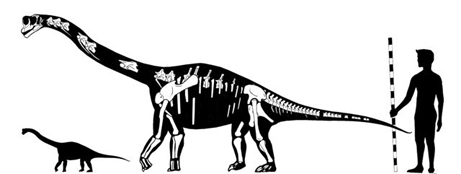

From the press release
When unusually small dinosaur fossils were found in a quarry on the northern edge of the Harz Mountains in 1998, it was initially assumed that these were the remains of a group of young dinosaurs. This was a fallacy, as the Bonn palaeontologist, Dr. Martin Sander, recently discovered. The microstructure of the bones, he says, makes it very likely that the animals involved were adults – a scientific sensation: at a maximum estimated weight of one tonne they were only a fiftieth the weight of their closest relatives, the brachiosaurs, and thus by far the smallest of the giant dinosaurs which have ever been found. The study will be published on 8 June in the journal 'Nature'.
In dinosaur bones there are what are known as growth marks, similar to the annual rings on trees. When the dinosaurs are young the growth marks are comparatively far apart, because the animal is still growing fast. When the dinosaur has reached its maximum size, the growth marks lie correspondingly close together. 'And it is precisely these tightly compressed marks that we have discovered just beneath the surface of the fossil's bones,' says Bonn lecturer Dr. Martin Sander, one of the few experts worldwide on the micro-structure of dinosaur skeletons. 'So the dinosaurs must have been fully grown when they died.'The newly discovered species is a dwarf compared with the other giant dinosaurs: the animals were only just longer and heavier than a car. 'They stopped growing when they reached 6 metres in length and a tonne in body mass,' Martin Sander estimates. Their cousins, by contrast, were up to 45 metres long and weighed in at 80 tonnes – as much as a small town of over 1,000 inhabitants. They are the biggest land animals which have ever existed.


No comments:
Post a Comment